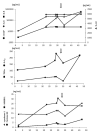Investigation of biomarkers in a rare case of fulminant necrotizing enterocolitis in a preterm infant
- PMID: 36631077
- PMCID: PMC10122973
- DOI: 10.5387/fms.2022-25
Investigation of biomarkers in a rare case of fulminant necrotizing enterocolitis in a preterm infant
Abstract
We encountered a very rare case of fulminant necrotizing enterocolitis (F-NEC) in a preterm male baby. The course of NEC and sepsis in this case was clearly different from the usual course. After onset at 14 days of life, catheter-related bloodstream infection was first assumed, and antibiotics and γ-globulin administration were started. However, 12 hours after onset, the baby's abdominal distension increased remarkably, and his entire abdominal wall turned red to purple. Escherichia coli were isolated from the blood culture, but the catheter tip culture was negative. Exchange transfusion was performed 32 hours after onset, but no significant changes were observed in the baby's general condition, and he died 46 hours after onset. The acute phase reactants of CRP and α1-acid glycoprotein increased, but haptoglobin did not. Although IL-1β and TNFα increased as expected with sepsis, IL-6, IL-8, IL-10, and G-CSF however increased to a greater extent than expected. From the above, we diagnosed the development of intestinal necrosis as a result of widespread intestinal ischemia, and that sepsis was associated with this poor condition.
Keywords: acute phase reactants; cytokine profiles; fulminant necrotizing enterocolitis; high mobility group box-1; preterm infant.
Conflict of interest statement
The authors have no conflicts of interest to declare.
Figures




References
-
- Hunter CH, Upperman JS, Ford HR, Camerini V. Understanding the susceptibility of the premature infant to necrotizing enterocolitis (NEC). Pediatr Res, 63: 117-123, 2008. - PubMed
-
- Shirahata A, Shirakawa Y, Murakami C. Diagnosis of DIC in very low birth weight infants. Semin Thromb Hemost, 24: 467-471, 1998. - PubMed
-
- Nakamura T, Yamada S, Yoshioka T. Measurement of plasma concentration of high mobility group box 1 (HMGB-1) in early neonates and evaluation off its usefulness. Clin Chim Acta, 413(1-2): 237-239, 2011. - PubMed
Publication types
MeSH terms
Substances
LinkOut - more resources
Full Text Sources
Medical
Research Materials
Miscellaneous

